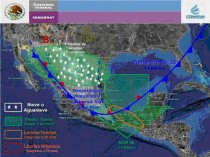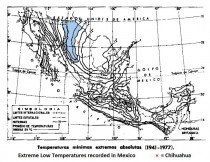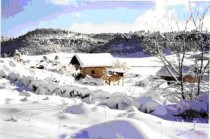By Dr. Richard Keen
My first visit to Mexico nearly forty years ago began on an icy note. I boarded the overnight train in Juarez and headed south to warmer climes, or so I thought. The Ferrocarril was unheated, and in the morning I wrote a short entry in my diary: “a miserable ride - frost inside the windows”. As the sun rose south of Chihuahua, the scene was quite unexpected - patches of snow lying in the shade of the Joshua trees and barrel cacti. It was New Year’s Day, 1973.

(Enlarged)
After returning home a few weeks later, I looked up some records of the climate of the Chihuahuan desert, and discovered that I should not have been surprised by finding freezing temperatures and snow in northern Mexico. Chihuahua, the capital of the large Mexican state of the same name, is the coldest major city in the country - sort of the Minneapolis of Mexico. Snowfall may occur several times in a winter, and the average daily minimum temperature in January is 2C (36F). It was about 20F when I rode through on the icy train.
Listed all-time record lows for different time periods include -10C (18F) on December 10, 1978 (SMN, Servicio Meteorologico Nacional); -11C (12F) ("Climates of the World” in the U.S. Department of Agriculture Yearbook, 1930); -12C (10F) December 29 2003 (Weather Underground daily data since 1975), -15C (5F) at meteorologyclimate.com, and -16C (3F) on mherrera.org. Just a few months ago, on Nov. 30 and Dec. 1, 2010, Chihuahua chilled at -11C (14F).

(Enlarged)
At the end of January, SMN issued a weather advisory: Intensa masa artica afectara el Norte de Mexico (you don’t need to read Spanish to get the gist). Snow was predicted for the northern third of the country. The arctic air mass arrived, and when the cold wave was over a week later, several records were gone. SMN’s “Comunicado de Prensa No. 034-11” summarized the freeze:
“Cold Front Number 26 led to a sharp drop in temperatures, especially in the mountain regions of Chihuahua, where temperatures fell to -21C. Meanwhile in Ciudad Juarez minus 18C was recorded, surpassing the record of February 1956, when it reached 15C degrees below zero.” Juarez, where I boarded the train 40 years earlier, recorded an even zero Fahrenheit, a full 5F colder than the previous low in 1956. Chihuahua maintained its status as Mexico’s coldest major city with a low of -18.5C (-1F), beating all previous records by at least 4 degrees F. The -21C (-5F) was recorded at a somewhat smaller city in the hills west of Chihuahua, Temosachic. Numerous other records are listed in the SMN Comunicado.

(Enlarged)
Although the historic cold wave set cold records in many of northern Mexico’s largest cities, it did not set a record for the country as whole. The listings of extremes on www.meteorologyclimate.com and www.mherrera.org list Mexico’s coldest reading as -28.5C (-19F) at Valerio in January 1949, but flag the record as “unofficial, suspicious, taken in a sinkhole”. Runner-up record lows include Los Lamentos -28C, San Juanito -27C, and La Rosilla -26.2C (-15F). The last location is in a high valley (2750 meters, 9000 feet) in the neighboring state of Durango. La Rosilla reached -20C (-4F) on February 5, 2011 - cold, but not a local record. Apparently the coldest air was too shallow to reach the high valley. Lows around -18C (zero F) have occurred several times this winter in La Rosilla, and apparently the town has a reputation as the “Frostbite Falls” of Mexico.

La Rosilla, Durango: Mexico’s Icebox (Enlarged)
A final note:
From “The Chihuahua FAQ”, “Owners must be very sensitive to the fact that short-haired Chihuahuas, and even long-haired ones, are vulnerable to the cold. In temperatures of 35-40 degrees Fahrenheit, I would recommend dressing your Chihuahua in a special dog sweater for brief walks. Walking your Chihuahua in temperatures below 35 degrees Fahrenheit is strongly discouraged, especially when there is a wind-chill factor.”
The native habitat of these dogs has been as much as 20C colder than the dog’s rated temperature of 2C. If the unusual cold persists, should Chihuahuas be deemed endangered, thus warranting international efforts to raise the global temperature for the sake of this remarkable species?
See PDF with information sources listed.
By Art Horn, Icecap Meteorologist
Members of Congress are asking something novel of NASA: to actually study space, not global warming. Representatives Bill Posey (R-FL), Sandy Adams (R-FL), Rob Bishop (R-UT) and others have sent a letter to House Appropriations Committee Chairman Harold Rogers (R-KY) and Commerce, Justice, and Science Subcommittee Chairman Frank Wolf (R-VA) asking for NASA to launch their efforts in a new direction - the old one.
For many years, NASA has been spending vast sums of money to study global warming, despite the efforts already undertaken at other federal agencies where such research is more appropriate. The letter asks that NASA refocus on what it was created to do, which is to maintain and develop our space program.
The amount of money being spent to study global warming, as a percentage of NASA’s budget, is startling - especially when one considers this is not part of NASA’s original mission. In budget year 2010, NASA spent 7.5% of its funding - over $1B - to study global warming. On top of that - the vast majority of federal stimulus money given to NASA in 2010 was spent on studying global warming.
As a whole, the U.S. federal government has spent $8.7 billion dollars on global warming studies - just in the past year! Many of the sixteen separate agencies doing this work were performing redundant research. In a time of federal spending cuts that are sure to come, much of this redundancy certainly can and must be eliminated, saving taxpayers billions. Certainly NASA should be one of the first to see funding drastically cut, or eliminated entirely, in this area.
The principal arm of global warming research for NASA is the Goddard Institute for Space Studies (GISS). That’s “Space” Studies, not climate. The Institute is located in New York City on the campus of Columbia University. The homepage of GISS states:
Research at the NASA Goddard Institute for Space Studies (GISS) emphasizes a broad study of global change.
No mention of anything to do with space exploration. How odd. The overview continues:
...which is an interdisciplinary initiative addressing natural and man-made changes in our environment that occur on various time scales - from one-time forcings such as volcanic explosions, to seasonal and annual effects such as El Nino, and on up to the millennia of ice ages - and that affect the habitability of our planet.
Under the section titled “More Research News & Features,” there are seven different news items, all dealing with global warming. Nothing about space or manned space missions or anything at all up there. It’s as if GISS has launched itself into an entirely different orbit, unrelated to its founding documents. The Goddard Institute for Climate Studies would be a much more accurate representation, though I think Dr. Robert Goddard would be surprised to learn how much influence he must have had in the field of climate research, rather than in developing liquid fueled rockets.
The shift of the GISS research effort is mysterious, but so is the trend of their long-term temperature records. In the late 1990s, GISS published a graph of the United States yearly average temperature from 1880 to 1998. From the graph it is clear that 1934 is nearly 1 degree Fahrenheit warmer than 1998, a very substantial amount. In fact, the graph ranked the four warmest years in order as: 1934, 1921, 1931, and 1998. But by 2009, an updated version of the graph shows some dramatic and remarkable changes: 1934, 1921, and 1931 are all now cooler than 1998!
Somehow in the past decade, these three years that concluded seven or eight decades ago managed to cool themselves, and 1998 found a way to warm itself, despite this all requiring time travel and maybe a volcano and a second sun.
How could “climate change” of this nature and magnitude take place when the readings were already determined? Apparently GISS found a way to “adjust” the temperatures of the past and present, by “changing” them. The obvious result of the change is twofold. The warmest decade of the last 130 years in the United States, the 1930s, has been “cooled” to make the current time period appear warmer. Another result of the change is that the years after 1970 have been adjusted warmer, to make the slope of temperature rise since then appear steeper and more significant.
Not only is GISS studying global warming, they are actually creating it! I guess all those billions of dollars were enough to buy a few degrees here and there.
This interesting interpretation of temperature by GISS is not limited to the United States data. The differences between the GISS global average temperature and the University of Alabama, Huntsville (UAH) satellite-derived average global temperature is revealing. Since 1998, the difference in the global temperature anomaly between GISS and UAH has increased to .72 degrees Fahrenheit, with GISS being the warmer. This difference is 70% of all the global warming anomaly since 1850! Some of this difference is due to the fact that GISS uses the period from 1951 to 1980 as its base period to calculate its anomalies. The period from 1945 to 1976 was a period of global cooling. By using this colder period as its base for calculating anomalies GISS gets larger warm temperature anomalies in its current evaluation of global temperature. The UAH uses the last 30 years as its base period.
As a consequence of these differences we get conflicting trends. The UAH data shows a decline of average global temperature of .34 degrees Fahrenheit during January 2011. On the other hand GISS found an increase of .27 degrees Fahrenheit during the same month. From March of 2010 to January 2011, UAH data shows a substantial global temperature drop of 1.01 degrees Fahrenheit. GISS was showing a downward trend in global temperature of 1.03 degrees Fahrenheit from March 2010 to December 2010, but then reversed the trend in January. It was almost as if GISS had enough of this temperature drop, and called a halt to it.
It appears that the climate in Washington is changing. We may see a significant drop in funding and a refocusing of NASA’s mission back to where it belongs, in space. The Goddard Institute for Data Adjustment may find that climate change does indeed have significant implications for the future, but those changes could be in a direction that GISS did not anticipate, and this time their attempts to change that direction may be out of their control.
See post.
Chris Woodward - OneNewsNow
The publisher of a website that advances the arguments of climate skeptics is criticizing a new grant that will allow schools to teach climate change.
High schools throughout Mississippi and Texas will soon be implementing material on climate change as part of a National Science Foundation’s (NSF) grant that includes a partnership between Mississippi State University, the University of Texas and Michigan State University.
Marc Morano, publisher of ClimateDepot.com and a former Republican staff member of the Senate Environment and Public Works Committee, says this is merely another “recruiting tool to get children into the ideological spectrum.”
“You cannot look at the details of this grant and think that they’re actually going to be teaching legitimate climate science,” he contends. “They’re going to be teaching baseless computer model scares of what may happen to scare children...into activism and not educate them at all in science.”
In his opinion, that is “a very sad development,” because children used to view science, technology and innovation as exciting outlets that made them optimistic about the future. But now, “their science courses are being hijacked by talk of human extinction and all of this ecological catastrophe,” Morano laments.
The four-year project will begin this summer with training sessions, where instructors will be introduced to the materials they will incorporate in the classroom beginning in the 2012 academic year. Post.


